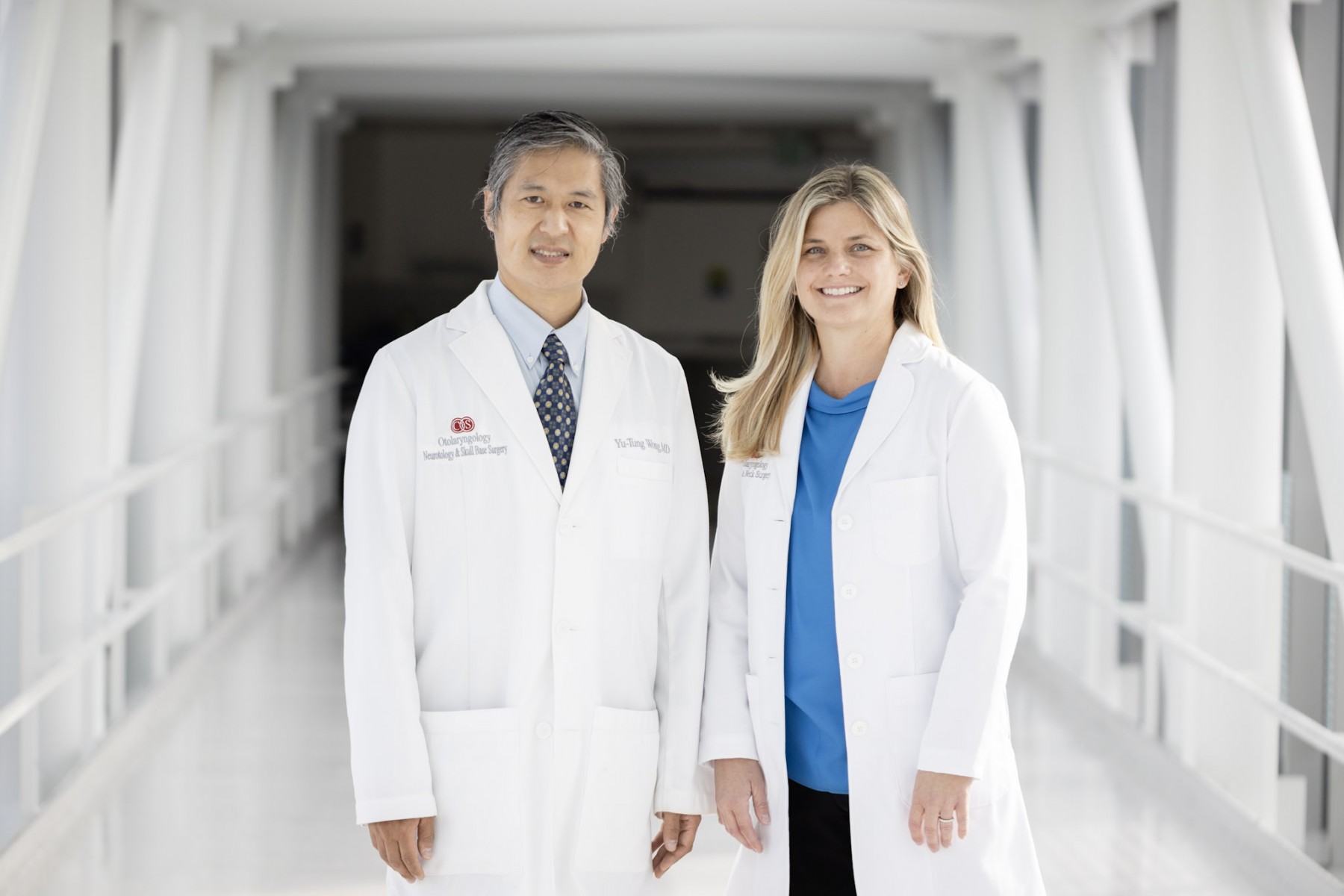Acoustic Neuromas: Benign but Complex and Potentially Devastating Tumors
Cedars-Sinai Expands Its Expertise in Treating Acoustic Neuroma Tumors
Cedars-Sinai has launched the Acoustic Neuroma and Lateral Skull Base Program, further expanding its expertise in treating patients with these noncancerous—but potentially life-altering—tumors.
Acoustic neuromas usually form in a set of nerves that run from the brain to the inner ear on each side of the head and carry signals that maintain hearing and balance. Acoustic neuromas can cause hearing loss and vertigo, and, as they grow, also can affect nerves that regulate facial movement and sensation, swallowing, speaking, and eye movement.
“Nerves in the area become stretched and splayed like a fan over the surface of acoustic neuromas,” said Mia Miller, MD, the program's director of Neurotology, a subspecialty of ear, nose and throat medicine focused on ear and skull base surgery. “When we remove acoustic neuromas surgically, our job is to take that fan off of the tumor without losing the nerve’s function.”
Treatment Options
Most acoustic neuromas, which usually are diagnosed through MRI imaging, develop in one ear only and have no known cause. If a tumor is small and the patient’s symptoms are minor, physicians often order additional imaging at regular intervals to monitor tumor growth, Miller said.
“If the tumor remains the same size, we can continue to observe without further treatment,” Miller said. “If it is growing, treatment is usually required.”
Acoustic neuromas that become large enough can cause life-threatening compression of the brain and spinal cord, or fluid buildup in the brain.
Targeted doses of radiation can halt tumor growth but usually don’t improve existing symptoms. Surgical removal of the tumor can alleviate symptoms such as vertigo, but is a delicate procedure best performed by an experienced neurotology-neurosurgery team.
“There’s really no margin for error, so the main thing about each procedure is complication avoidance,” said John Yu, MD, director of Neurosurgery for the program. “A millimeter movement of a nerve can permanently affect the patient’s hearing or ability to use the muscles of the face.”
John Yu, MD, director of Neurosurgery for the program. “A millimeter movement of a nerve can permanently affect the patient’s hearing or ability to use the muscles of the face.”
Tumor size, a patient’s age, general health and symptoms all factor into the choice of a treatment plan.
“I have a good discussion with each patient about the pros and cons of each option,” said neurotologist Yu-Tung Wong, MD, who is also part of the acoustic neuroma team. “I also encourage patients to meet with one of my neurosurgery colleagues to get their perspective.”
Restoring Balance
Douglas Lilly, 44, a construction superintendent from Bakersfield, was diagnosed with an acoustic neuroma in May 2021 by a local ear, nose and throat specialist after years of debilitating vertigo.
“Going up ladders, I would start to get really dizzy,” Lilly said. “It was starting to interfere with my daily activities. Three or four times over a three-year period I spent two days in bed because the dizziness was so bad.” Lilly also developed hearing loss and a constant ringing in his right ear.
Lilly’s local doctor referred him to Wong, who brought in Yu to discuss a treatment plan.
“He’s a young guy, and removal of the tumor was really the best option, particularly because radiosurgery wouldn’t address his vertigo,” Wong said.
Acoustic neuromas are shaped like an ice cream cone, with a cone-shaped portion in the canal that leads to the inner ear and a rounded top growing toward the brain.
“The neurosurgeon generally removes the part growing toward the brain and the neurotologist removes the part in the canal,” said Yu, also vice chair of Neurosurgical Oncology in the Department of Neurosurgery at Cedars-Sinai and professor of Neurosurgery.
Acoustic neuroma procedures can last several hours and require close collaboration. “There are tricky parts to every tumor that require deliberation and discussion,” Wong said. “Having two sets of eyes makes a big difference.”
Lilly, who had his procedure in November, had a midsize tumor, so Wong and Yu accessed it through a small opening in the skull behind his ear. For smaller tumors that haven’t grown out of the nerve canal, surgeons approach from in front of the ear. Both approaches preserve the patient’s existing hearing.
opening in the skull behind his ear. For smaller tumors that haven’t grown out of the nerve canal, surgeons approach from in front of the ear. Both approaches preserve the patient’s existing hearing.
If an acoustic neuroma has grown so large that it causes substantial hearing loss, surgeons often remove it through a corridor that runs through the inner ear. This approach sacrifices any remaining hearing, but unlike the first two, doesn’t require brain tissue to be moved aside. This reduces post-surgical swelling, headaches and nausea for patients, Yu said.
Helping With Recovery
Wong and Yu successfully removed Lilly’s tumor. Lilly initially had balance problems—common after acoustic neuroma surgery, which can disrupt the balance nerve—but within 10 days, his brain began to adjust.
For patients whose balance problems persist, Cedars-Sinai offers specialized physical therapy called vestibular therapy. The acoustic neuroma team also includes facial nerve experts and facial and ocular plastic surgeons to help patients recover from disruption of the facial nerve, serving as a one-stop shop for care for these tumors.
“By consolidating and expanding our acoustic neuroma expertise through the addition of Dr. Miller and other new members of our faculty, we are able to offer cohesive, targeted care for these patients,” said Keith L. Black, MD, chair of the Department of Neurosurgery, professor of Neurosurgery and the Ruth and Lawrence Harvey Chair in Neuroscience, who is also a member of the acoustic neuroma team.
Additional experts include facial plastic and reconstructive surgeon Matthew Lee, MD, assistant professor of Surgery, and otolaryngologist and balance specialist Edward Cho, MD.
Hearing loss due to acoustic neuromas isn’t reversible, but patients with a usable level of hearing after surgery can experience some improvement. “Through a hearing aid, the patient can get meaningful information from that ear,” Miller said.
Patients with complete hearing loss in the affected ear have the option of wearing a Bluetooth-enabled BiCROS hearing aid. These convey sound from the deaf ear to a hearing aid in the other ear, so the patient can perceive sounds from both sides of their head.
Lilly chose another option: to have a device implanted behind the deaf ear that uses bone conduction to transmit sound to the other side.
Lilly will go in for an outpatient procedure to place the implant soon. Meanwhile, much of his life is back to normal.
“About the third week after surgery, I started to really get everything back,” Lilly said. “Six weeks afterward, I went back to the gym. Eight weeks later, I was at 100%. At 12 weeks, you can’t tell that I even had surgery.”
Learn more on the Cedars-Sinai Blog: Neuroendoscopy Revolutionizes Skull Base Surgery




